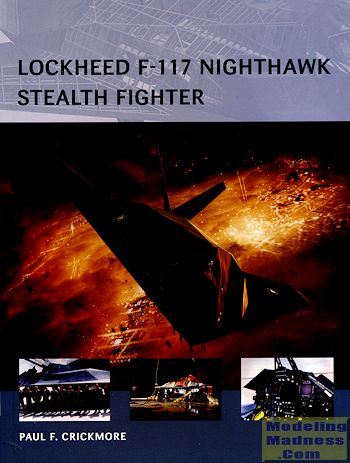 Aviation
enthusiasts may not admit it, but we love a secret. This is especially true when
it comes to things that fly. We have, over the years, found out about a number
of 'black' projects that involve some rather remarkable aircraft, and one that
amazingly was kept secret from the vast majority was the F-117 Nighthawk.
Aviation
enthusiasts may not admit it, but we love a secret. This is especially true when
it comes to things that fly. We have, over the years, found out about a number
of 'black' projects that involve some rather remarkable aircraft, and one that
amazingly was kept secret from the vast majority was the F-117 Nighthawk.
From 1975 until its initial unveiling in 1988, literally hundreds if not
thousands of men and women knew about the 'stealth fighter', yet not a word
actually leaked out. Oh sure, there were suppositions and Testors sold what is
undoubtedly the king of models in terms of sales with its rather fanciful
'F-19'. IN fact, they were not the only ones to jump on the bandwagon and the
interesting aspect of all this is that everyone was wrong about how the airplane
looked.
What we go was a very ungainly and unaerodynamic jet that was not a
fighter but actually a night attack bomber. Not a curve in sight, but with an
airframe festooned with facets, all specifically designed to scatter the radar
frequencies of the 'bad guys'. The plane was never truly invisible, but was what
is referred to as a 'Low Observable' or LO aircraft.
The airplane was designed by Lockheed was was not even invited to submit
a proposal when the aircraft was first suggested. In fact, it was Northrop that
came closest to meeting the design paramaters, but as things often go, they did
not get a contract for prototypes, but their work did not go entirely for naught
as it was used in the equally impressive B-2 bomber.
Prototypes were built and lost before the test program was fully
complete, but enough was learned to go ahead with preproduction aircraft. More
testing, more changes and a loss or two during this part of development. An
entire new complex was built in Tonopah, NV, far from prying eyes and the place
that housed the USAF's 'MiG squadron. The aircraft were shipped in at night,
assembled and flown only at night. In fact, those crashes which occurred were at
night and often due to pilot disorientation.
During this time the plane was put through its paces and evolved into a
wing with three squadrons. Eventually, it was realized that they'd have to come
into the light and the wing went public. It also eventually moved from Tonopah
to Holloman AFB, a move that severely reduced operating costs as there was no
need to fly everything in. I can recall the early days in 1988 and 1989 when the
plane was first introduced. When I went to Edwards AFB in 1989 to see one for
myself, the security around the airplane was very impressive with double rows of
barriers each patrolled by an armed guard.
As with most warplanes, this one went to war. Its first combat was with
Desert Shield when it flew probably the first mission of the war against command
and control structures in Baghdad. No one was sure if the plane would meet its
expectations so that mission was rather stressful. It was felt that half the
planes that participated would be lost. However, the system worked superbly and
not a single plane was lost in thousands of missions. One was not even hit by a
bullet!
By the time of its second combat tour in Kosovo, things had changed. The
Serbians had learned a bit and they were able to track one long enough to shoot
it down. Another was badly damaged, but returned to base. The last combat
operation was quite limited and during the invasion of Iraq. There, it was
obvious that the aircraft and systems were no longer cutting edge. No planes
were lost, but the writing was on the wall. Finally, in 2008, the last plane
flew into storage at Tonopah, back into the hangers from which they were
originally assembled.
In this book, the author looks into the background and the development
of the F-117, a pretty good story all in itself. The full combat and operational
career is also covered. There are a few color profiles for some specially
painted planes, but the F-117 was basically black and codes. There are a number
of excellent photos of the aircraft and some equally nicely done artwork. As
usual, there is a large cutaway on the back two pages. A great read and highly recommended.
November 2014
For more on the complete line of Osprey books,
visit http://ospreygrp.com. In the US, it is
Osprey Direct at 44-02 23rd St, Suite 219, Long Island City, NY 11101., where you can
get a catalogue of available books.
If you would like your product reviewed fairly and
fairly quickly, please
contact
the editor or see other details in the
Note to
Contributors.
 Aviation
enthusiasts may not admit it, but we love a secret. This is especially true when
it comes to things that fly. We have, over the years, found out about a number
of 'black' projects that involve some rather remarkable aircraft, and one that
amazingly was kept secret from the vast majority was the F-117 Nighthawk.
Aviation
enthusiasts may not admit it, but we love a secret. This is especially true when
it comes to things that fly. We have, over the years, found out about a number
of 'black' projects that involve some rather remarkable aircraft, and one that
amazingly was kept secret from the vast majority was the F-117 Nighthawk.